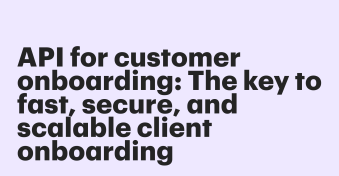Automation is your key to increasing efficiency and reducing manual work. But how do you implement it?
There are two different approaches you might want to take when it comes to automating your workflows: no-code platforms and API-based solutions. Both are beneficial in their own way, and deciding between the two will depend on what your business needs and what resources and technical capabilities you have.
This article will cover the key differences between no-code and API, their use cases, and the pros and cons of each to help you figure out which is the right fit for you.
Let’s dive in!
What is an API?
An API, or application programming interface, is a digital bridge between two software systems, allowing for the exchange of data or functionality. It’s what enables tools like your CRM and website to communicate with each other automatically.
APIs typically require the expertise of a developer to implement and manage, but they can be highly powerful and flexible. They are great for complex systems with advanced integration needs, as they give you a higher level of control.
Here’s a deeper dive into APIs.
What does no-code mean?
No-code platforms let users build workflows or applications without having to write code. Instead, they use tools like drag-and-drop builders, logic flows, or templates.
Particularly useful for non-technical users, no-code means your teams can launch automations faster without having to wait on developers because everything is on a single platform.
Pro-Tip: No-code is a solid option for teams that need to move quickly and efficiently but don’t want to rely on engineering support.
What does low-code mean?
Low-code platforms are a middle ground between no-code and full custom development. They let users build apps or workflows with minimal coding–think drag-and-drop tools combined with some scripting for custom logic.
They include some technical scripting, but you don’t have to worry about things like infrastructure or backend setup. You get the flexibility to build more complex workflows while still moving faster than traditional development.
Low-code also makes it easier to work with APIs — ideal for more technical users who want a bit more control without starting from scratch. Many no-code tools even offer low-code features as an add-on for power users.
No-code vs API: what’s the difference?
Both no-code and APIs aim to automate your workflows, but they are significantly different in how they are built and who they’re built for.
Let’s take a closer look:
| Feature | No-code | API |
| Skill level | Non-technical users | Developers required |
| Flexibility | Limited to platform capabilities | Fully customizable |
| Speed to deploy | Fast—visual builders and templates | Slower—requires coding and testing |
| Upfront cost | Lower—no dev needed | Higher—developer resources required |
| Scalability | Good for small to medium workflows | Ideal for complex, enterprise-level systems |
| Security control | Platform-managed | Custom, developer-controlled |
| Maintenance | Handled by platform | Requires internal oversight |
When to use no-code platforms
Use no-code platforms when:
- You have limited tech resources and need to launch quickly
- You have straightforward workflows for approvals, document generation, notifications, etc.
- You want the power to build your own solutions without high developmental costs
- You are prototyping or testing new workflows
For example, your sales team could use PandaDoc as a central resource to automatically generate contracts from your CRM data, send them off for eSignature, and store them. Plus, you can do all of that and more without writing any code.
No-code platforms are especially useful for startups and small businesses that need to focus on speed and agility without the heavy lifting of coding.
When to use API-based solutions
It’s best to use APIs when:
- You need highly customized workflows
- You have large amounts of data or users
- Your business has strict compliance/security or integration requirements
- You need your systems to work in real time across multiple platforms
- You can access to internal or external developers
When you’re working with enterprise-grade automations, APIs are the way to go. Same goes for back-end integrations or customer-facing systems that call for excellent control and performance.
Pros and cons of no-code vs API
Here’s a breakdown of all the pros and cons of both approaches:
| Feature | No-code platforms | API-based solutions |
| Pros | Fast to launch | Highly customizable |
| Easy for non-technical users | Scales well with complex systems | |
| Lower upfront development costs | Full control over logic, data, and security | |
| Great for rapid prototyping | Integrating systems in real time | |
| Cons | Limited customization | Requires developer resources |
| Not ideal for complex workflows | Longer implementation time | |
| Platform-dependent functionality | Higher upfront and maintenance costs |
Using both together
So, do you have to choose one or the other? The short answer is no.
In fact, a lot of companies take a hybrid approach. This could mean using no-code tools for your front-end workflows—think user-facing forms, document generation, and internal automations—and utilizing APIs on the back end for tasks like data processing, system integration, etc.
This way works well because you can benefit from the speed and simplicity of no-code platforms where you can, while getting the control, flexibility, and scalability of APIs for the more complex back-end systems.
No-code vs API: deciding what’s best for your business
Choosing no-code vs. API will come down to your individual needs as a business.
For example, if you need to move quickly without developer support, no-code might be the better option for you in this case. Or, if you have a need for custom logic or deep system integrations, APIs could be more useful.
It’s common to have a mix of both be the right solution. It’s always safe to start with no-code, then scale or extend your setup with APIs as your business and its needs evolve.
Align your automation strategy with your business goals
While no-code gives you speed and accessibility, APIs give you power and precision. The key is choosing the right tool at the right time to more effectively implement automation. And remember, you can always use a combination of both!
PandaDoc offers solutions that allow you to create, send, and manage proposals, quotes, contracts, and eSignatures speedily, all without writing any code. If you’re ready to automate your workflows, we’ve go you covered with ton of built-in features and integrations with top tools like HubSpot, Salesforce, and more.
We also offer our PandaDoc API for your more advanced needs for integration. Our API changes the game for your workflow, allowing you to create, manage, and eSign documents right on your platform.
Plus, our API can help you significantly speed up your processes for a more effective workflow—just ask our client, Colonies. With PandaDoc API, they were able to reduce time spent getting signatures by 25%!
“PandaDoc’s API integration has been a transformative tool for Colonies as we continue to scale across new properties and countries. Each lease is automatically tailored to meet regional legal requirements and property specifics, saving countless hours in document preparation and significantly reduced errors. Automating these processes within our platform has not only improved tenant satisfaction but also empowered our team to focus on expanding our reach and enhancing our offerings.”
– Thomas Guillot, VP Digital at Colonies
Ready to see how PandaDoc can work for you? Request a free demo today.
FAQ
What are some examples of no-code tools?
There are popular no-code tools that can help you automate tasks, manage data, build websites, and create business documents, including PandaDoc, Zapier, Make, Airtable, and Webflow. All of these tools make it easier to smooth out workflows and launch solutions quickly without dev support.
Which is more secure: API or no-code?
Both options are secure, but APIs give you more control on a granular level. APIs give developers the power to define custom encryption, access rules, and data handling, while no-code platforms follow standard security practices. Essentially, both are safe to use but no-code offers less customization.
What is a no-code API?
A no-code API is a platform that lets users interact with APIs without need to write code. This is usually through built-in connectors, UI components, or automation builders.
Is API the same as code?
No, these are not the same thing. An API is a protocol, not a code. When you use an API, it typically involves writing code unless you’re using it via a no-code interface.

